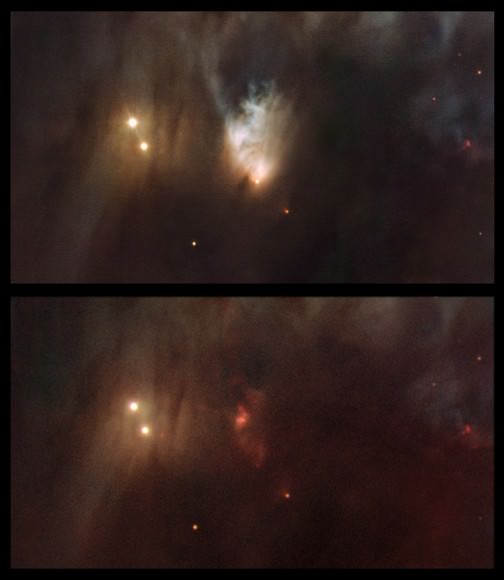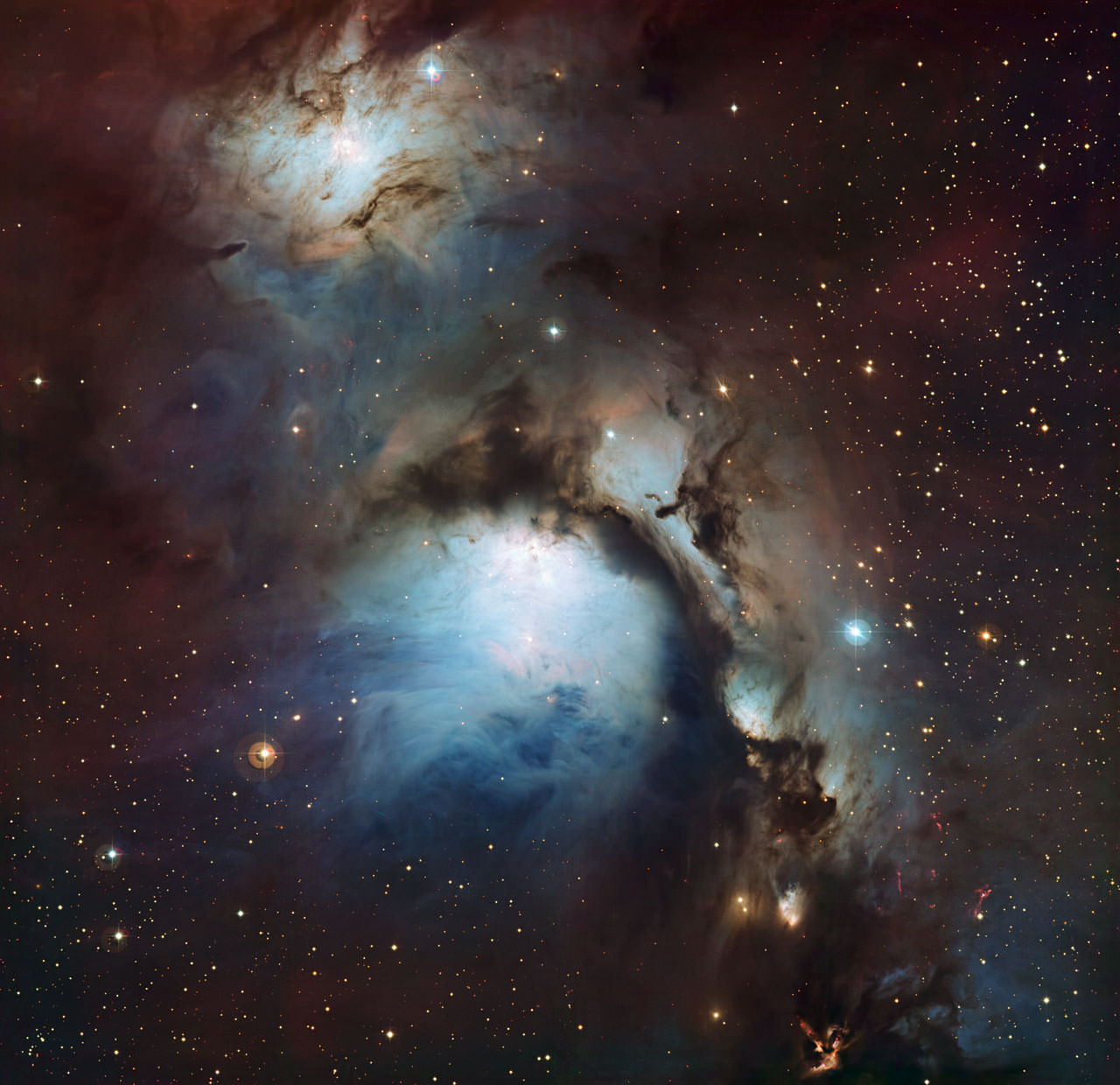[/caption]
Here’s another “Hidden Treasure” from the European Southern Observatory, from the astrophotography competition where amateurs create images from unused ESO data. In this new image of Messier 78, brilliant starlight ricochets off dust particles in the nebula, illuminating it with scattered blue light and creating what is called a reflection nebula. Almost like fog around a street light, a reflection nebula shines only with the light from an embedded source that illuminates the dust. This image was taken with the Wide Field Imager on the MPG/ESO 2.2-metre telescope at the La Silla Observatory in Chile. Comparing this image with others previously taken of Messier 78 shows that remarkably, this object has changed significantly in the last ten years.
This beautiful image was the overall winner of ESO’s Hidden Treasures 2010 astrophotography competition created by Igor Chekalin, who won with his image of this stunning object.
Messier 78 can easily be observed with a small telescope, being one of the brightest reflection nebulae in the sky. It lies about 1350 light-years away in the constellation of Orion (The Hunter) and can be found northeast of the easternmost star of Orion’s belt.
For those of you who want to take a look on your own:
Right Ascension: 05:46.7
Declination: +00:03
Distance: 1.6 (kly)
Visual Brightness: Magnitude 8.3
This image contains many other striking features apart from the glowing nebula. A thick band of obscuring dust stretches across the image from the upper left to the lower right, blocking the light from background stars. In the bottom right corner, many curious pink structures are also visible, which are created by jets of material being ejected from stars that have recently formed and are still buried deep in dust clouds.
Two bright stars, HD 38563A and HD 38563B, are the main powerhouses behind Messier 78. However, the nebula is home to many more stars, including a collection of about 45 low mass, young stars (less than 10 million years old) in which the cores are still too cool for hydrogen fusion to start, known as T Tauri stars. Studying T Tauri stars is important for understanding the early stages of star formation and how planetary systems are created.

But this object has changed significantly in the last ten years. In February 2004 the experienced amateur observer Jay McNeil took an image of this region with a 75 mm telescope and was surprised to see a bright nebula — the prominent fan shaped feature near the bottom of this picture — where nothing was seen on most earlier images. This object is now known as McNeil’s Nebula and it appears to be a highly variable reflection nebula around a young star.
This color picture was created from many monochrome exposures taken through blue, yellow/green and red filters, supplemented by exposures through an H-alpha filter that shows light from glowing hydrogen gas. The total exposure times were 9, 9, 17.5 and 15.5 minutes per filter, respectively.
Source: ESO


Heaven and hell at the same time.
The blues in this image are so beautiful. The centre round pale nebulosity is like looking into the entrance of Aladdin’s Cave for the very first time. You can even imaging the two darker blue nebulae at the lower portion of the main round pale blue nebula, looking like mist cascading out of the cave like a waterfall or being sucked in by the difference in atmospheric pressure.
My own favourite part are the twisted fighting or playing serpents (centre and slightly right) that are tightly intertwined, and whose two muddied bodies wind down and up respectively along the edge of the nebula.
A beautiful sight indeed!
Looking at the large image from the ESO site, there is an odd slow moving object in the bottom left quarter of the image. It is near the brightest yellow star in this quadrant of the picture, placed in an ESE direction from this star and is just immersed in the blue nebulosity. It is spectrally in order of three blue, green and red dots — suggesting a tumbling object. As the colours are indication of the filter being used, the distance travelled is 9, 9, and 17.5 minutes totally about 35.5 minutes. It is certainly not an image fault!
I wonder if anyone in ESO has even noticed it?
Note: there are plenty of galaxies in the background too, along glowing deep-red by the Hydrogen-alpha image; suggesting significant absorption by the nebulosity reddening the emitted light of them significantly.
You have to look at the 31mb tiff or the original to see the foreground object, but its not an artifact for sure – good eyes. I hope you sent an email off to ESO.
With a 75mm scope! Nice~ He used a 3-inch Takahashi FCT-76 refractor to make this discovery proving once again that there is no substitute for quality optics!
what’s this “unused ESO data” ?
Many of the worlds largest telescopes store archival data and make it available to the general public. Of most interest to amateurs is the imaging data taken by these scopes (as opposed to photometric or spectroscopic data), and with some patience, Photoshop or similar and a few acquired skills, you can download the data and make your own image composites etc.
As for why some of this archived data is referred to as ‘unused’, sometimes there are observations taken by the scopes that astronomers can’t use for their science program for a number of technical reasons (e.g. the seeing may not have been good enough, too much light pollution from the moon in the end, instrumental problems, the offsets for the observation were not calculated correctly and the object of interest was out of FOV etc etc etc).
Thanks Astrofiend. I discovered some software called SAOImage ds9 which can retrieve data from a variety of places including ESO. Haven’t quite worked out how they make images like the above yet tho. I presume some kind of different colour image layering?
Absolute stunner, and processed very nicely. I can see why it took the honours in the competition!